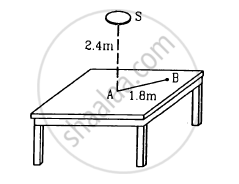Advertisements
Advertisements
प्रश्न
Light from a point source falls on a screen. If the separation between the source and the screen is increased by 1%, the illuminance will decrease (nearly) by ____________ .
पर्याय
0.5%
1%
2%
4%
उत्तर
2%
Illuminance is given by
\[E = \frac{I_o \cos\theta}{r^2}\]
\[\theta = 0^0 \]
\[\frac{\Delta r}{r} = 1 \% \]
\[E = \frac{I_o}{r^2}\]
Differentiating,
\[dE = - 2\frac{I_o}{r^3}dr\]
As approximation differentials are replaced by \[\Delta, \]
\[\Delta E = - 2\frac{I_o}{r^3}\Delta r\]
\[ \Rightarrow \Delta E = - 2\frac{I_o}{r^2}\left( \frac{\Delta r}{r} \right)\]
\[ \Rightarrow \Delta E = - 2E\left( \frac{\Delta r}{r} \right)\]
\[ \Rightarrow \frac{\Delta E}{E} = - 2\left( \frac{\Delta r}{r} \right)\]
\[ \Rightarrow \frac{\Delta E}{E} = - 2 \times 1 \% = - 2 \% \]
Since, negative sign implies decrease; hence, illuminance decreases by 2% .\]
APPEARS IN
संबंधित प्रश्न
What is the luminous flux of a source emitting radio waves?
The sun is less bright at morning and evening as compared to at noon although its distance from the observer is almost the same Why?
Why is the luminous efficiency small for a filament bulb as compared to a mercury vapour lamp?
Three light sources A, B and C emit equal amount of radiant energy per unit time. The wavelengths emitted by the three source are 450 nm, 555 nm and 700 nm respectively. The brightness sensed by an eye for the sources are XA, XB and XC respectively. Then, ________ .
As the wavelength is increased from violet to red, the luminosity ____________ .
A photographic plate placed a distance of 5 cm from a weak point source is exposed for 3 s. If the plate is kept at a distance of 10 cm from the source, the time needed for the same exposure is _____________ .
A photographic plate is placed directly in front of a small diffused source in the shape of a circular disc. It takes 12s to get a good exposure. If the source is rotated by 60° about one of its diameter, the time needed to get the same exposure will be ___________ .
A point source of light moves in a straight line parallel to a plane table. Consider a small portion of the table directly below the line of movement of the source. The illuminance at this portion varies with its distance r from the source as ___________ .
The brightness-producing capacity of a source
(a) does not depend on its power
(b) does not depend on the wavelength emitted
(c) depends on its power
(d) depends on the wavelength emitted
A room is illuminated by an extended source. The illuminance at a particular portion of a wall can be increased by
(a) moving the source
(b) rotating the source
(c) bringing some mirrors in proper positions
(d) changing the colour of the source.
Mark the correct options.
(a) The luminous efficiency of a monochromatic source is always greater than that of a white light source of same power.
(b) The luminous efficiency of a monochromatic source of wavelength 555 nm is always greater than that of a white light source of same power.
(c) The illuminating power of a monochromatic source of wavelength 555 nm is always greater than that of a white light source of same power.
(d) The illuminating power of a monochromatic source is always greater than that of a white light source of same power.
A source emits 45 joules of energy in 15 s. What is the radiant flux of the source?
A light source emits monochromatic light of 555 nwavelengthm. The source consumes 100 W of electric power and emits 35 W of radiant flux. Calculate the overall luminous efficiency.
A source emits 31.4 W of radiant flux distributed uniformly in all directions. The luminous efficiency is 60 lumen watt−1. What is the luminous intensity of the source?
A point source emitting 628 lumen of luminous flux uniformly in all directions is placed at the origin. Calculate the illuminance on a small area placed at (1.0 m, 0, 0) in such a way that the normal to the area makes an angle of 37° with the X-axis.
A point source emitting light uniformly in all directions is placed 60 cm above a table-top. The illuminance at a point on the table-top, directly below the source, is 15 lux. Find the illuminance at a point on the table-top 80 cm away from the first point.
Figure shows a small diffused plane source S placed over a horizontal table-top at a distance of 2.4 m with its plane parallel to the table-top. The illuminance at the point Adirectly below the source is 25 lux. Find the illuminance at a point B of the table at a distance of 1.8 m from A.

Two light sources of intensities 8 cd and 12 cd are placed on the same side of a photometer screen at a distance of 40 cm from it. Where should a 80 cd source be placed to balance the illuminance?
